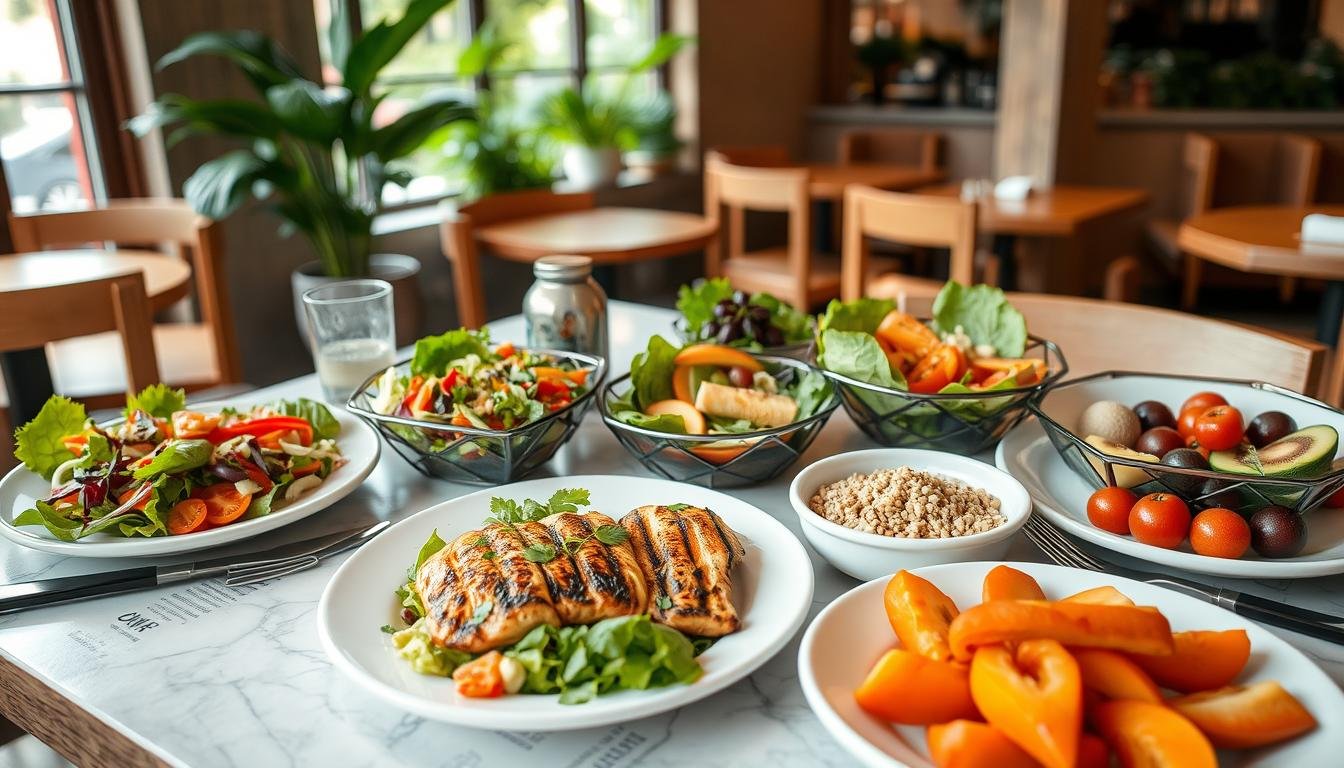Dining out can be fun, but it can also be hard to stay healthy. Whether it’s a quick lunch or a long dinner, choosing healthy options is key. This guide will help you pick the right foods, control your portions, and enjoy meals that are good for you.
You’ll learn how to read menus and find foods that are full of nutrients. We’ll cover how to control your portions, choose better drinks, and eat mindfully. This way, you can enjoy eating out without feeling guilty or compromising your health.
Understand Restaurant Menus
Before you go to a restaurant, it’s key to know the restaurant menu terminology and find the healthy choices. This helps you make smart choices and pick dishes that fit your diet.
Decoding Menu Terminology
Understanding a restaurant menu can seem tough, but it’s easier with some tips. Look for words like “grilled,” “baked,” or “steamed.” These usually mean the food is healthier. On the other hand, words like “fried,” “breaded,” or “creamy” often mean the dish is high in calories and fat.
Identifying Healthier Options
Looking for healthy menu options can greatly improve your meal. Choose lean proteins like grilled chicken or fish. Pair them with sides like roasted veggies or a fresh salad. For carbs, go for whole-grain choices like brown rice or quinoa instead of refined starches.
| Healthier Menu Options | Less Healthy Options |
|---|---|
| Grilled chicken or fish | Fried chicken or fish |
| Roasted vegetables | French fries |
| Whole-grain options (brown rice, quinoa) | White bread, pasta, or potatoes |
| Salad with light dressing | Salad with creamy dressing |
Portion Control Strategies
Learning to control your portions is key to a balanced diet, even when eating out. By using smart techniques, you can enjoy your meals without eating too much. Let’s explore some effective ways to be mindful and watch your calorie intake.
Sharing plates with friends is a simple yet effective method. It lets you try different dishes without eating everything yourself. Also, take leftovers home to avoid eating more than you need in one sitting.
Being aware of what you see on your plate is also important. Use smaller plates to eat less. Make sure your meal has a mix of healthy foods like veggies, lean proteins, and whole grains.
It’s also crucial to listen to your body’s hunger and fullness signals. Enjoy each bite and stop when you’re just satisfied, not stuffed. This mindful eating helps you have a better relationship with food and prevents eating too much.
| Portion Control Strategies | Benefits |
|---|---|
| Sharing plates with dining companions | Allows you to enjoy a variety of dishes without overindulging |
| Packing up leftovers | Ensures you don’t consume more than your body needs in a single sitting |
| Using smaller plates | Helps you naturally reduce your portion sizes |
| Practicing mindful eating | Develops a healthier relationship with food and prevents mindless overeating |
By using these portion control tips, you can enjoy your meals while staying mindful of your calorie intake. This approach supports your overall health and well-being.
Navigating Dietary Restrictions
Dining out can be tricky for those with dietary needs. But, it doesn’t have to be hard. If you’re gluten-sensitive, vegan, vegetarian, or have other dietary needs, there are many tasty and healthy options.
Gluten-Free Dining
For those with celiac disease or gluten intolerance, finding gluten-free meals can be a challenge. But, many restaurants now clearly label gluten-free dishes. This makes it easier to find meals that fit your dietary needs.
When you dine out, ask about the kitchen’s gluten-free preparation. This ensures your meal is safe for you to eat.
Vegan and Vegetarian Options
More restaurants are adding vegan and vegetarian dishes to their menus. You can find everything from veggie-packed meals to meat-free alternatives. Just check the menu descriptions and ask your server about how your meal is prepared.
By talking about your dietary needs, you can enjoy a great meal. Whether you’re gluten-free, vegan, or vegetarian, you can find delicious options. With a bit of research and asking questions, you can confidently order and enjoy your meal.
How to Make Healthy Choices When Eating Out
Dining out can be tough for keeping a healthy lifestyle. But, with the right strategies, you can have a nutritious and enjoyable meal. Understanding menus, controlling portions, and knowing dietary restrictions help you make good choices.
Start by getting to know menu terms. Choose dishes that are grilled, baked, or steamed. These methods use less fat and calories. Stay away from fried, breaded, or creamy foods, as they have more unhealthy fats and calories.
Controlling portions is crucial when eating out. Restaurant meals are often too big. To eat less, share an entree or ask for a to-go box to save half.
- Look for healthier options like lean proteins, fresh veggies, and whole grains.
- Watch out for hidden calories in sauces, dressings, and breads.
- Choose dishes rich in vitamins, minerals, and fiber.
By using these tips, you can make smart choices and enjoy dining out while staying healthy.
Mindful Eating Practices
When you go out to eat, being more mindful can make your experience better. Mindful eating means eating slowly, enjoying each bite, and noticing the flavors and textures. It helps you stay focused, avoid eating too much, and enjoy your food more.
Slowing Down and Savoring
One important part of mindful eating is eating slowly. Don’t rush through your meal. Take time to enjoy the smells, colors, and tastes of your food. Eating slowly helps you digest better and feel full longer.
- Make sure you have enough time for your meal, without distractions like phones.
- Take small bites and pause between them to really enjoy the flavors and textures.
- Use your senses to notice the details of your food, like the crunch of veggies or the smoothness of sauces.
By eating slowly and savoring your food, you can feel more thankful and enjoy your meals more. This makes your dining experience more rewarding and satisfying.
| Mindful Eating Practices | Benefits |
|---|---|
| Slowing down and savoring each bite | Enhances appreciation, aids digestion, and promotes feelings of satiety |
| Avoiding distractions during meals | Increases mindfulness and helps prevent mindless overeating |
| Focusing on the senses: sight, smell, taste, and texture | Deepens the dining experience and promotes a greater connection with the food |
By using these mindful eating tips, you can make your relationship with food better. This can lead to healthier choices and a happier, healthier you.
Choosing Nutrient-Dense Dishes
When you go out to eat, choose dishes that are good for you. Look for meals made from whole, natural foods. This way, you can enjoy your food without feeling guilty and stay healthy.
Prioritizing Whole Foods
Choose dishes with lots of whole foods like fresh fruits, veggies, whole grains, lean proteins, and healthy fats. These foods are full of vitamins, minerals, and other good stuff that helps your body.
Try to find menu items that use whole foods and avoid fried or heavily processed foods. Good choices include grilled salmon with veggies, quinoa bowls with roasted veggies, or vegetable stir-fries.
| Nutrient-Dense Dish | Key Nutrients |
|---|---|
| Grilled Salmon with Roasted Vegetables | Omega-3 fatty acids, vitamins A, C, and K, and essential minerals like iron and potassium |
| Quinoa and Roasted Vegetable Bowl | Protein, fiber, B vitamins, and a variety of antioxidants from the vegetables |
| Vegetable-Based Stir-Fry | Fiber, vitamins, and minerals from the diverse array of vegetables |
By picking nutrient-dense dishes and focusing on whole foods, you can feed your body well. And you’ll have a great time eating out too.
Balancing Indulgences
Eating out doesn’t mean giving up on health goals. You can enjoy treats and still eat well. It’s all about being calorie-conscious and mindful of what you eat.
Think of eating out as a special treat. Don’t overdo it every time. Save your big treats for special moments like birthdays or romantic dinners. This way, you enjoy your splurges without ruining your health goals.
When you do treat yourself, choose wisely. Look at the menu ahead of time and pick what you really want. Enjoy each bite slowly. This makes your treat more satisfying without eating too much.
Adding healthy foods to your meal can also help. Start with a salad or veggies, then enjoy a richer dish. This way, you get both taste and nutrition.
The aim is to enjoy eating out without losing sight of health. By making smart, calorie-conscious choices, you can love the food you eat and stay healthy.
Healthy Beverage Alternatives
When you’re out to eat, it’s tempting to grab sugary drinks or alcohol. But, there are better choices that can satisfy your thirst and match your meal. Opting for hydrating drinks helps keep your diet balanced and your health in check.
Hydrating Choices
It’s important to drink water, even more so when you’re eating out. Here are some refreshing, healthy drinks to try:
- Water – Whether it’s plain, flavored with fruit, or bubbly, water is the best choice for staying hydrated.
- Unsweetened tea – From green to herbal, these teas come in many flavors without any sugar.
- Infused sparkling water – Mix in sliced fruits or herbs for a tasty, fizzy drink.
- Low-fat milk – It’s a good source of calcium and protein, making it a healthy drink to have with your meal.
- 100% fruit juice – In small amounts, it’s a good way to get important vitamins and minerals.
| Beverage | Calories | Sugar | Nutrients |
|---|---|---|---|
| Water | 0 | 0g | Hydration |
| Unsweetened Tea | 2-5 | 0g | Antioxidants |
| Infused Sparkling Water | 0 | 0g | Hydration, Flavor |
| Low-fat Milk | 120 | 12g | Calcium, Protein |
| 100% Fruit Juice | 120 | 28g | Vitamins, Minerals |
By picking healthy beverage alternatives and hydrating choices, you can enjoy your meal out while staying healthy.
Meal Planning for Success
Starting a healthy lifestyle doesn’t have to end when you leave your kitchen. By using meal planning strategies when dining out, you can keep your diet balanced. Let’s look at how to enjoy your restaurant meals while staying healthy.
First, research restaurants before you go. Check their menus online to find places with healthy options. Look for restaurants that offer gluten-free or vegetarian/vegan dishes. This way, you can choose wisely before you arrive.
- Plan by looking at the menu before you go. Know the healthy choices and portion sizes to make smart picks.
- Think about sharing a big dish with someone or getting smaller portions. This helps control what you eat.
- Add a side salad or steamed veggies to your meal. They add nutrients.
- Don’t snack without thinking. Set your fork down and enjoy the taste and texture of your food.
Spending a bit of time on meal planning lets you enjoy dining out while staying healthy. Practice mindful eating and make choices that support your health, even when eating out.
Reading Nutrition Information
Understanding nutrition labels and calorie counts is key to healthy eating at restaurants. By reading menus and nutrition guides, you can make better choices. This helps you stay on track with your diet goals.
Understanding Calorie Counts
Calorie counts on menus are helpful for a healthier lifestyle. Calories show the energy in food. Knowing this helps you choose the right portion sizes and meal nutrition.
But, remember, calories aren’t everything. Nutrient density and ingredient quality matter too. These factors help decide if a dish is healthy.
To use calorie info wisely, pick meals with balanced nutrients and moderate calories. Avoid high-calorie, low-nutrient foods. Choose dishes that are both nutritious and mindful of calories.
| Dish | Calories | Protein (g) | Carbs (g) | Fat (g) |
|---|---|---|---|---|
| Grilled Salmon with Roasted Veggies | 350 | 35 | 25 | 15 |
| Creamy Fettuccine Alfredo | 850 | 25 | 80 | 50 |
| Quinoa and Vegetable Stir-Fry | 450 | 20 | 60 | 20 |
By knowing the calorie and nutrient details of menu items, you can make choices that support your health. This is true whether you’re trying to keep, gain, or lose weight.
Building a Balanced Plate
When you eat out, making a balanced plate is important. It ensures your meal is both nutritious and filling. You can do this at any restaurant by mixing different food groups and balancing your macronutrients.
Begin by filling half your plate with colorful fruits and veggies. They are full of vitamins, minerals, and fiber. Choose grilled, roasted, or steamed options to avoid extra fats and oils. The other half can have lean proteins like chicken or fish, and whole grains like brown rice or quinoa.
If the menu doesn’t have balanced plate choices, ask for nutritious alternatives. You might swap a side salad for fries or ask for sauces on the side. These small changes can make your meal healthier and more balanced.





